Sleep in Style: Top 8 Things to Put Over Your Bed
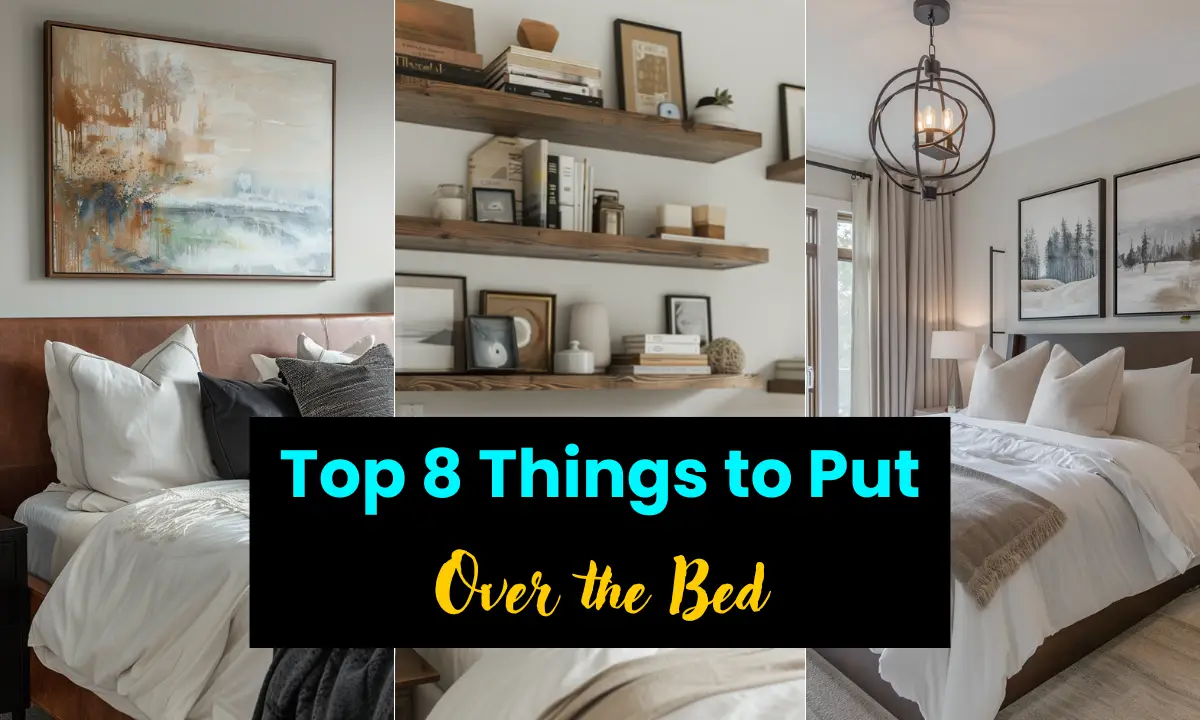
Bedroom decor sets the tone for your home.
The space above your bed offers untapped potential for creative expression.
Top interior designers have mastered this area, transforming it into a focal point.
Their innovative approaches range from statement art to textured wall treatments.
These expert-inspired ideas can elevate your bedroom from ordinary to extraordinary.
Let’s explore how to make the most of this often-overlooked space.
We’ll delve into 10 designer-approved methods to enhance your bedroom’s ambiance.
These techniques blend style and functionality, catering to various tastes and preferences.
Get ready to reimagine your bedroom’s upper reaches with these professional insights.
1. Oversized Artwork
Large-scale art pieces command attention above your bed.
A single, bold artwork can define your bedroom’s aesthetic.
Choose a piece that reflects your personality and complements your decor.
Creating a focal point with large-scale pieces:
Opt for artwork that spans at least two-thirds of your headboard’s width.
Abstract paintings or photographs work well in this space.
Consider a diptych or triptych for added visual interest.
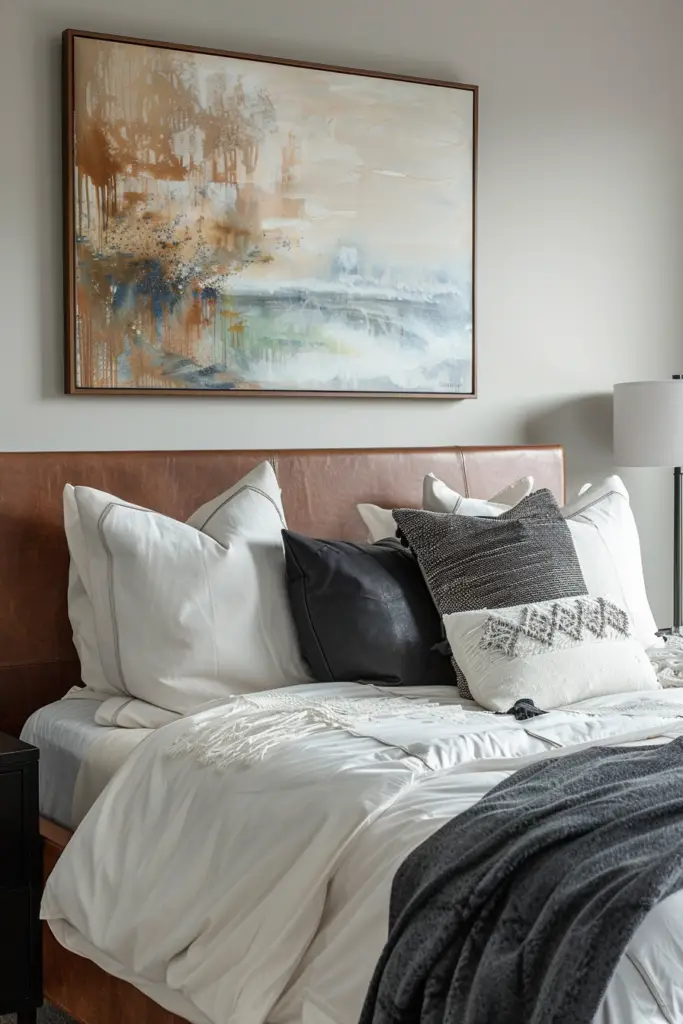
Tips for selecting statement art:
Match the artwork’s style to your bedroom’s theme.
Pay attention to color palettes that enhance your existing decor.
Scale is crucial; ensure the piece doesn’t overwhelm the room.
Proper Hanging Techniques for Safety and Impact:
Use sturdy mounting hardware rated for the artwork’s weight.
Position the piece at eye level when standing for maximum impact.
Secure the frame with earthquake putty to prevent shifting during sleep.
2. Mirrors
Mirrors above the bed create an illusion of space and amplify light.
They serve as functional art, enhancing your bedroom’s ambiance.
A well-placed mirror can become a striking focal point in your sleep sanctuary.
Using mirrors to add depth and reflect light:
Position mirrors to capture and bounce natural light around the room.
Angled mirrors can create intriguing visual effects.
Use mirrored panels to simulate windows in darker spaces.
Choosing the right size and style:
Select a mirror that complements your bed’s proportions.
Consider unique shapes like sunbursts or asymmetrical designs for added flair.
Frame styles should harmonize with your existing decor elements.
Placement considerations for optimal effect:
Hang mirrors at eye level for the most flattering reflection.
Avoid placing mirrors directly opposite windows to prevent glare.
Group smaller mirrors for a gallery wall effect if one large mirror feels overwhelming.
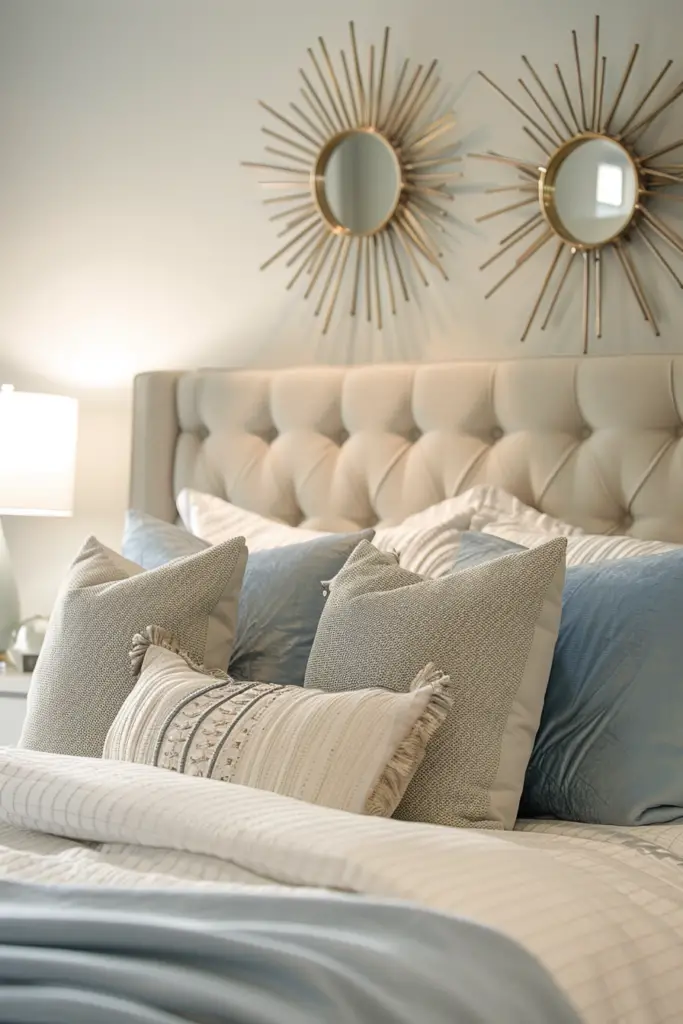
3. Sculptural Lighting
Lighting fixtures above your bed can double as artistic statements.
The right lighting choice can transform your bed area into a captivating focal point.
Types of designer-approved lighting fixtures:
Consider sleek pendant lights for a modern touch.
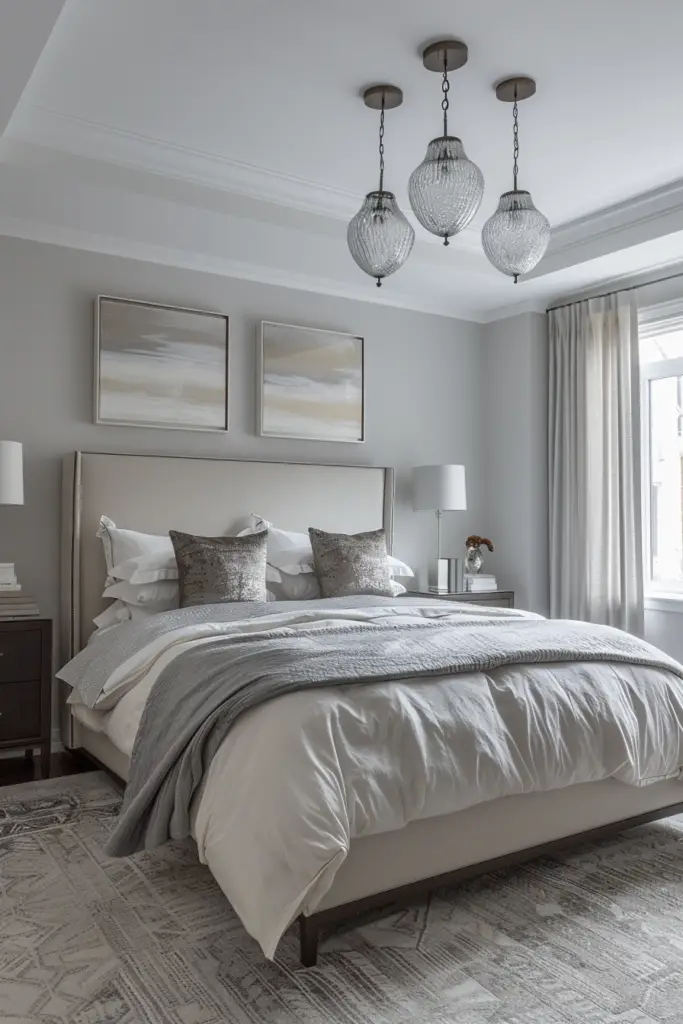
Wall sconces offer a classic look with space-saving benefits.
Chandeliers add drama and luxury to larger bedrooms.
Balancing form and function:
Choose fixtures that complement your decor while providing adequate light.
Dimmable options allow for adjustable ambiance.
Look for designs that direct light both up and down for versatility.
Installation tips for over-bed lighting:
Ensure fixtures are securely anchored to support beams.
Position lights to avoid glare when you’re in bed.
Install a separate switch for convenient control from your bedside.
4. Textured Wall Treatments
Textured walls add depth and interest to your bed area.
They create a tactile focal point that draws the eye.
Designers often use texture to inject personality into bedroom spaces.
Types of textures:
Wood panels bring warmth and natural charm.

Textured wallpapers offer endless pattern options.
3D wall panels create striking geometric effects.

Incorporating texture without overwhelming the space:
Limit textured treatments to the bed wall for balance.
Choose subtle textures in small rooms to avoid visual clutter.
Pair textured elements with solid colors in bedding and decor.
DIY options vs. professional installation:
Peel-and-stick wallpapers are ideal for DIY enthusiasts.
Wood paneling kits offer a manageable weekend project.
Complex 3D panels often require professional installation for the best results.
5. Curated Floating Shelves
Floating shelves offer versatile decor options above your bed.
They provide space for personal touches and artistic displays.
Designers use these shelves to create dynamic visual interest.
Styling shelves like a designer:
Vary heights and lengths for an asymmetrical look.
Group items in odd numbers for visual appeal.
Leave some space to avoid cluttered appearances.
Mixing books, objects, and small artworks:
Combine hardcover books with decorative bookends.
Display small framed prints or photographs.
Add dimensional objects like sculptures or plants for depth.
Maintaining a cohesive look:
Stick to a consistent color palette across displayed items.
Use repetitive elements to create visual rhythm.
Rotate objects seasonally to keep the display fresh and interesting.
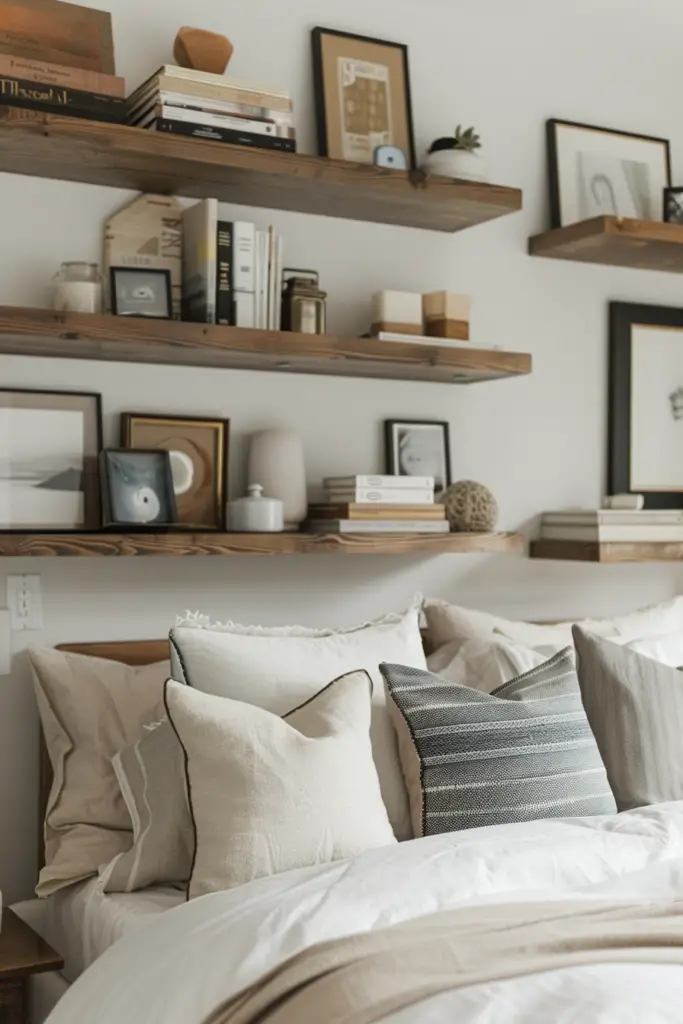
6. Eclectic Gallery Walls
Gallery walls transform your bed area into a personal art exhibition.
They showcase a curated collection of images and memories.
Designers use this technique to add character and depth to bedroom spaces.
Creating a designer-approved mix of art and photos:
Combine various art styles for visual interest.
Include personal photographs alongside professional prints.
Mix different mediums like paintings, sketches, and digital art.
Tips for arranging a cohesive gallery:
Start with a central anchor piece.
Create balance by alternating sizes and orientations.
Maintain consistent spacing between frames for a polished look.
Framing and color coordination ideas:
Use matching frames for a unified appearance.
Alternatively, mix frame styles within a cohesive color palette.
Choose mat colors that complement your bedroom’s overall scheme.
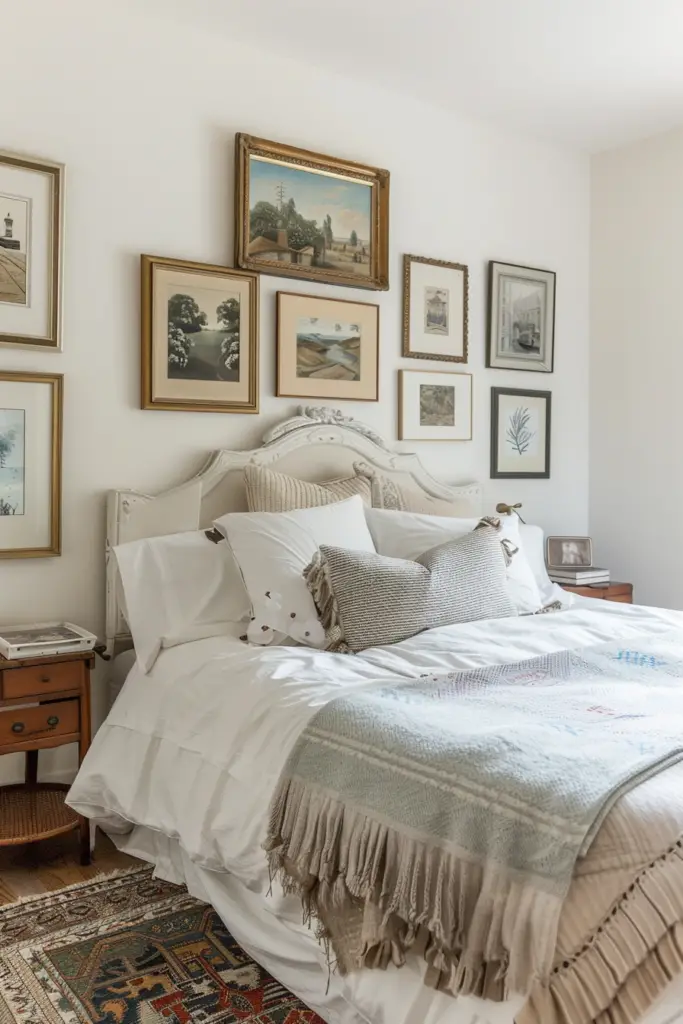
7. Architectural Elements
Architectural details add sophistication to your bed area.
They create visual interest and depth without clutter.
Designers use these elements to elevate a room’s overall aesthetic.
Adding molding or wooden slats for interest:
Install crown molding for a classic touch.
Create a geometric pattern with wooden slats.
Use picture frame molding to define wall sections.
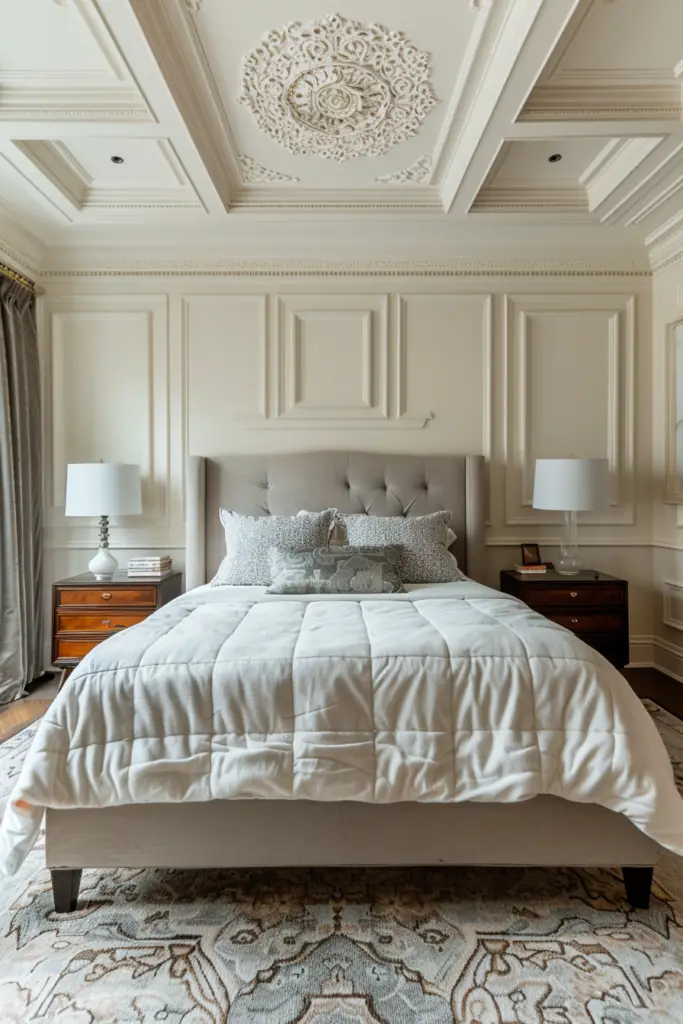
Incorporating architectural details in different styles:
Ornate plaster medallions suit traditional spaces.
Sleek metal inlays complement modern interiors. Reclaimed wood beams add rustic charm.
8. Natural and Organic Elements
Organic decor brings a sense of calm to your bedroom.
Natural elements connect your space to the outdoors.
Designers use these pieces to create a serene, earthy atmosphere.
Using branches, driftwood, or organic sculptures:
Mount a large driftwood piece as a focal point.
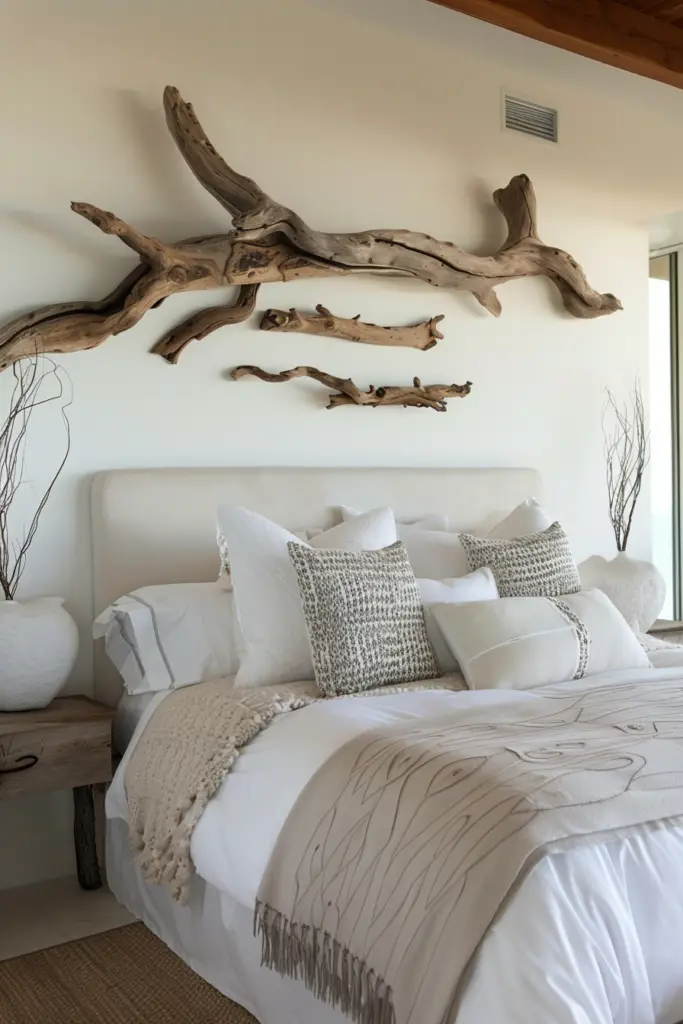
Arrange sculptural branches in a tall vase.
Display abstract wooden sculptures for artistic flair.
Incorporating natural elements in minimalist design:
Choose one statement piece for maximum impact.
Opt for items with clean lines and smooth textures.
Use neutral-toned natural elements to maintain simplicity.
Balancing organic pieces with other decors:
Pair natural elements with sleek metallic accents.
Complement organic shapes with geometric patterns.
Use soft textiles to offset rough natural textures.
Conclusion
Designer-inspired ideas offer diverse options for your bed area.
Adapt these concepts to reflect your unique style and preferences.
Mix elements like artwork, mirrors, and textures for a personalized look.
Consider your room’s size and existing decor when choosing enhancements.
Experiment with different combinations to find your perfect design.
Remember, a well-styled headboard area elevates your entire bedroom.
Create a space that inspires relaxation and showcases your personality.
- 16 Funky Living Room Ideas to Bring Colors, Fun & Personality to Your Space - November 9, 2025
- 12 Small Bathroom Ideas on a Budget That Make Your Space Look Bigger & Stylish - November 6, 2025
- 20 Modern Boho Living Room Ideas That Are Cozy & Absolutely Stunning - November 2, 2025
